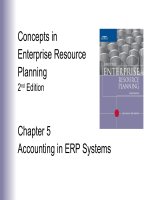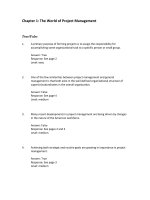Lecture Project management in practice (Fifth Edition) – Chapter 5: Scheduling the project
Bạn đang xem bản rút gọn của tài liệu. Xem và tải ngay bản đầy đủ của tài liệu tại đây (942.37 KB, 43 trang )
Project Management in Practice
Fifth Edition
Chapter 5
Scheduling the Project
Copyright © 2014 John Wiley & Sons, Inc.
51
Introduction
•
•
•
Project schedule is the project plan in an
altered format
It is a convenient form for monitoring and
controlling project activities
Can be prepared in several formats
–
–
–
Gantt charts
PERT network
CPM network
52
PERT and CPM Networks
•
•
PERT and CPM developed independently in
1950’s
Program Evaluation and Review Technique
(PERT)
–
–
•
U.S. Navy, BoozAllen Hamilton, and Lockheed
Aircraft
Probabilistic activity durations
Critical Path Method (CPM)
–
–
Dupont De Nemours Inc.
Deterministic activity durations
53
The Language of PERT/CPM
•
Activity
–
–
•
Event
–
–
–
•
A task or set of tasks
Uses resources and time
An identifiable state resulting from completion of one
or more activities
Consumes no resources or time
Predecessor activities must be completed
Milestones
–
Identifiable and noteworthy events that mark
significant progress
54
The Language of PERT/CPM
Continued
•
Network
–
•
Path
–
•
A series of connected activities between two events
Critical path
–
•
A diagram of nodes (activities or events) and arrows (directional
arcs) that illustrate the technological relationships of activities
The set of activities on a path that, if delayed, will delay the
completion date of the project
Critical Time
–
The time required to complete all activities on the critical path
55
Building the Network
•
There are two ways of displaying a project
network
Activities on arrows (AOA) network
1.
•
•
Activities on nodes (AON) network
2.
•
•
•
The activities are shown as arrows and events as nodes
Generally more difficult to draw but depicts the technical
relationships of the activities well
Each task is shown as a node and the technological
relationship is shown by the arrows
AON network usually associated with CPM
AOA network usually associated with PERT
56
Sample AON Network
Table 51
Figure 53
57
Sample AOA Network
Table 51
Figure 56 (a)
58
Which to Use?
•
•
•
Mostly AON used throughout this textbook
AON used by most of the popular software
AON networks are easier to draw by hand
–
•
Large (20+ activities) AOA networks are
difficult to draw
Software to draw AOA networks is
expensive
59
Finding the Critical Path and Critical
Time
•
•
•
•
•
•
•
ES: Earliest start time
EF: Earliest finish time
LS: Latest start time
LF: Latest finish time
Displayed on node as shown
ES + completion = EF
LS + completion = LF
Figure 59
510
A Sample Problem for Finding the
Critical Path and Critical Time
Table 52
511
The Complete Network
Table 52 and Figure 58
512
The Critical Path and Completion
Time for Sample Project
Figure 510
513
Notes on Sample Project
•
•
All activities, and thus all paths, must be
completed to finish the project
The shortest time for completion of the network is
equal to the longest path through the network
–
•
In this case aehj
If any activity on this path
is even slightly delayed,
the project will be delayed
514
Calculating Activity Slack
•
•
•
•
•
•
•
ES: Earliest start time
EF: Earliest finish time
LS: Latest start time
LF: Latest finish time
Slack = LS – ES
Slack = LF – EF
Either method of calculating slack gives the same
results
515
Managerial Implications
•
•
•
The primary attention of the project
manager must be to activities on the critical
path
If anything delays one of these activities,
the project will be late
Projects are easier to manage when there is
project slack
516
Doing It the Easy Way—Microsoft
Project (MSP)
•
Data is entered using a tab entry table
–
•
•
•
Shown on next slide
MSP automatically numbers each activity
MSP has numerous options for viewing the
data
MSP automatically draws an AON network
–
Shown on later slide
517
A Microsoft Project Version of Data
in Table 52
Table 53
518
A Microsoft Project Version of the
PERT/CPM Network from Table 53
Figure 511
519
Calculating Probabilistic Activity
Times
•
•
•
•
Figure below shows distribution of all possible
durations for some task
Estimate a is such that the actual duration of the
task will be a or lower less than 1 percent of the
time
Estimate b is such that the actual finish time will
be b or greater less than 1 percent of the time
Estimate m is the most likely time
Figure 513
520
Activity Expected Time and
Variance
TE
Var
( a 4m b)
6
2
(b a )
6
2
521
95 Percent Level
•
•
Task will be a or lower 5 percent of the
time
Task will be b or greater 5 percent of the
time
(b a )
3 .3
522
90 Percent Level
•
•
Task will be a or lower 10 percent of the
time
Task will be b or greater 10 percent of the
time
(b a )
2 .6
523
The Probabilistic Network
•
•
•
Expected time (TE) for each activity is calculated
Variance (σ2) for each activity is calculated
TE for each activity is used to find the critical path
and critical time for the network
–
•
Slack is calculated in the usual fashion
The variance (σ2) of a path is the sum of the
activity variances for that path
–
Standard deviation (σ) is the square of the variance
524
The Probabilistic Network, an
Example
Table 54
525









